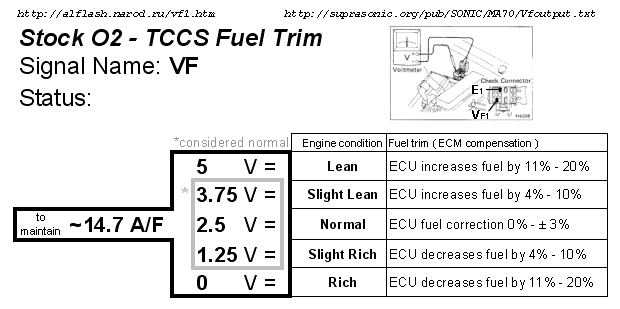I have read a few post about the Vf signal on this forum, as you guys saying we can check the fuel for lean or rich while the engine is running, i wonder how do i do that, which wire to connect? do i need to make a diagnosis box myself contains a few leds? can i do it like the one we can do the engine diagnosis, connect the T signal to one side of a switch and the other side goes to the ground?
For the Vf signals, a monitor mod question?
- Thread starter MA70_452
- Start date
You are using an out of date browser. It may not display this or other websites correctly.
You should upgrade or use an alternative browser.
You should upgrade or use an alternative browser.
Connect a voltmeter to the two spots in this pic:

Should give you a range from 0-5v that shows what the stock ECU is doing to try to adjust fuel delivery.

Should give you a range from 0-5v that shows what the stock ECU is doing to try to adjust fuel delivery.
MA70_452 said:Could i leave it connected while i am driving the car?
Heck yeah. It was meant for that. I usually just bend a paper clip - works great.
thesupe87 said:Heck yeah. It was meant for that. I usually just bend a paper clip - works great.
I hope you're referring to E and T with that comment or that you're using paper clips to connect a meter to Vf. Do not short Vf and do not drive the car with E and T shorted.
Grim, in your photo I see TE2. Do you have a pin there or is the hole empty? I ask because I've never seen a Supra with Test Mode.
So, do you mean that i can connect the Vf1 and E1 together by using paper clip while my car is on the move, yeah? Also how can i monitor it, if i just use paper clip to connect Vf1 and E1? Do i need a Led bulb connect between them or what?
Seems you're getting a bit confused.
1) E1 is ground, same as the battery negative cable.
2) Vf is a signal output. Do not short it to ground.
3) T is a signal input. It's ok to short to ground.
4) You connect a voltmeter across Vf and E1 (or battery negative) to monitor it.
5) You connect a jumper (paper clip) across T and E1 to check for diagnostic codes.
Vf and T are used for two different functions. However shorting E1 and T will put Vf into a different mode, a mode not used for the kind of Vf monitoring you want to do.
6) It's ok to leave a meter or other device connect to E1 and Vf while driving the car.
7) It's not ok to leave a jumper between T and E1 while driving the car.
Vf outputs different levels of voltage: 0 to 5 volts in 5 discrete steps. You can't monitor it with a single led. Use a voltmeter or get someone knowledgeable in electronics to build you a little box with multiple leds and comparator circuits.
1) E1 is ground, same as the battery negative cable.
2) Vf is a signal output. Do not short it to ground.
3) T is a signal input. It's ok to short to ground.
4) You connect a voltmeter across Vf and E1 (or battery negative) to monitor it.
5) You connect a jumper (paper clip) across T and E1 to check for diagnostic codes.
Vf and T are used for two different functions. However shorting E1 and T will put Vf into a different mode, a mode not used for the kind of Vf monitoring you want to do.
6) It's ok to leave a meter or other device connect to E1 and Vf while driving the car.
7) It's not ok to leave a jumper between T and E1 while driving the car.
Vf outputs different levels of voltage: 0 to 5 volts in 5 discrete steps. You can't monitor it with a single led. Use a voltmeter or get someone knowledgeable in electronics to build you a little box with multiple leds and comparator circuits.
Fuzz420
Are U Here 2 take My Baby
jetjock said:Vf outputs different levels of voltage: 0 to 5 volts in 5 discrete steps. You can't monitor it with a single led. Use a voltmeter or get someone knowledgeable in electronics to build you a little box with multiple leds and comparator circuits.
A Dot/Bar LED driver such as the LM3914 would work great for this.
Yes, off the top of my head I believe it would. Tell your uncle he's got a sharp nephew  .
.
MA70: The graphic above is somewhat misleading in that Vf is not a true indicator of A/F ratio. It's a trim value. It can only inform you of how much correction the ECU is adding or subtracting in it's attempt to achieve stoichiometric. It is not an indicator of what the mixture actually is. For example Vf can be other than 2.5 and the mixture still be at or near 14.7
MA70: The graphic above is somewhat misleading in that Vf is not a true indicator of A/F ratio. It's a trim value. It can only inform you of how much correction the ECU is adding or subtracting in it's attempt to achieve stoichiometric. It is not an indicator of what the mixture actually is. For example Vf can be other than 2.5 and the mixture still be at or near 14.7
Correct, as usual.jetjock said:Yes, off the top of my head I believe it would. Tell your uncle he's got a sharp nephew.
MA70: The graphic above is somewhat misleading in that Vf is not a true indicator of A/F ratio. It's a trim value. It can only inform you of how much correction the ECU is adding or subtracting in it's attempt to achieve stoichiometric. It is not an indicator of what the mixture actually is. For example Vf can be other than 2.5 and the mixture still be at or near 14.7
How can I adjust my graphic to be more accurate?
Right now I guess it depicts ideal condition.
Is the OX terminal the actual O2 sensor signal? That'd be the best place to pull a signal if you're looking to build a DIY A/F Guage. You might be able to find data on signal per A/F on some of the manufacturers' sites.
CRE: Yes, the OX pin is the raw O2 signal. It's one of the three the most valuable troubleshooting signals in the car if you learn how to use it. Narrowband sensor signals are standardized so no need to hunt down manufacturer's data. Google "oxygen sensor" and you'll find more than you ever wanted to know.
Ismns: Everything on the right side of the graphic is good. It's the left side that's the problem. Lose the "is running xxxx" and "higher/lower a/f". The problem is with a Vf offset the engine may be running rich or lean or it may not be. It depends on whether the problem that caused it lies withing the ECU's ability to correct for it. I'd explain but I'm traveling at the moment.
Ismns: Everything on the right side of the graphic is good. It's the left side that's the problem. Lose the "is running xxxx" and "higher/lower a/f". The problem is with a Vf offset the engine may be running rich or lean or it may not be. It depends on whether the problem that caused it lies withing the ECU's ability to correct for it. I'd explain but I'm traveling at the moment.
Sounds as if you all need to borrow an oscilloscope...
I have ran these sort of tests several times while actually driving a car, the oscilloscope will let you see the voltage pattern in relation to time. Our regular voltmeters don't update near as fast as an oscilloscope does, thats the problem with just testing this with a voltmeter - sure you could get a reading for 2.5V and say yeah man, I am where I need to be! But the thing of that is - is it really steady at 2.5V? Or is it jumping around? With the oscilloscope it can make out a graph... here is what I suggest you were to do to really test out your O2 sensor...
Have the car running, all hooked up, set up the oscilloscope to a good time frame and have the highest volt reading set to like 5 or 10 volts... once you have the oscilloscope configured, get onto the car, give her all shes got for a few seconds and when your done off it, pause the graph - then review the graph and see exactly what happened....
If the graph shows you stayed at a steady voltage - there is something wrong. When you are accelerating it should call for a richer mixture. It should never tell the CPU to go lean.... and if it does end up staying at practically stoichiometric (or just above stoichiometric) the entire time, my best guess would be that the CPU is staying in open loop, or it just hasn't reached closed loop yet.
With this tool, you can run all kinds of tests... and another note is, don't expect your O2 sensors to put out good readings when you have your car at idle without really running it yet, this is why I would suggest running your car up just a little bit before doing these sort of tests - O2 sensors have to heat up to operate, and yeah there are some heated O2 sensors - but even those need a little bit of influence to get running good.
I have ran these sort of tests several times while actually driving a car, the oscilloscope will let you see the voltage pattern in relation to time. Our regular voltmeters don't update near as fast as an oscilloscope does, thats the problem with just testing this with a voltmeter - sure you could get a reading for 2.5V and say yeah man, I am where I need to be! But the thing of that is - is it really steady at 2.5V? Or is it jumping around? With the oscilloscope it can make out a graph... here is what I suggest you were to do to really test out your O2 sensor...
Have the car running, all hooked up, set up the oscilloscope to a good time frame and have the highest volt reading set to like 5 or 10 volts... once you have the oscilloscope configured, get onto the car, give her all shes got for a few seconds and when your done off it, pause the graph - then review the graph and see exactly what happened....
If the graph shows you stayed at a steady voltage - there is something wrong. When you are accelerating it should call for a richer mixture. It should never tell the CPU to go lean.... and if it does end up staying at practically stoichiometric (or just above stoichiometric) the entire time, my best guess would be that the CPU is staying in open loop, or it just hasn't reached closed loop yet.
With this tool, you can run all kinds of tests... and another note is, don't expect your O2 sensors to put out good readings when you have your car at idle without really running it yet, this is why I would suggest running your car up just a little bit before doing these sort of tests - O2 sensors have to heat up to operate, and yeah there are some heated O2 sensors - but even those need a little bit of influence to get running good.



